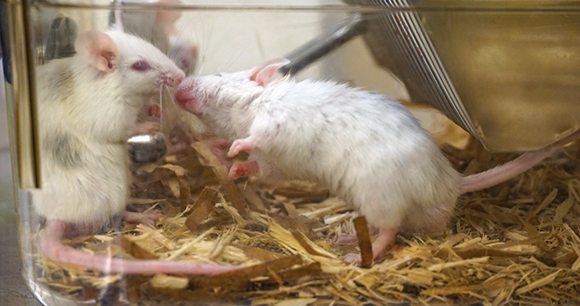Breaking Up the Fight Before It Begins: Detecting Early Signs of Inter-male Aggression in Mice
Inter-male aggression in mice continues to challenge laboratory animal husbandry personnel, as intervention strategies are typically applied at the cage level without a good understanding of how individual behavior is affected. Aggression mitigation may be improved if individual interactions were better understood.

Male laboratory mice often form despotic hierarchies, where one dominant individual attacks all the other cage mates. If fighting is observed, mitigation strategies targeting the dominant mouse would likely be the most effective in reducing conflict. Unfortunately, it is unknown if this dominance structure is the same across different types of mice or group sizes. The ability to identify signs of aggression early would improve our understanding of social dynamics and greatly improve the welfare of victimized mice. But it presents a challenge. Groups plagued by aggression are typically identified by the presence of a wounded mouse. By the time tissue damage is visible through the fur, aggression has already escalated. To improve our ability to detect early signs of inter-male aggression, interactions between male mice in stable social groups were examined.
In this study, which was funded by an AWI Refinement Grant, social behavior was continuously recorded over two 24-hour periods in two mouse strains of known tendencies housed in groups of 3 or 5: SJL (high aggression) and B6N-Tyrc-Brd (moderate aggression). All instances of aggression, submission, and allo-grooming (a positive social interaction) were recorded, while the actor and recipient mouse of each interaction was noted.
Aggression data were used to calculate (1) the social rank of each mouse within a cage, (2) aggression density (the proportion of possible interactions between individuals in a cage), and (3) directional consistency (DC, a measure of how often attacks occur without retaliation). Welfare checks for severe wounding were conducted daily, and if any mice exceeded our humane endpoint criteria, they were euthanized. Unfortunately, mice in four cages met this criteria, leaving 19 cages. Additionally, the proportion of time spent active, sleeping in a group, and sleeping alone were collected for each individual mouse.
Overall, aggression density was low, and individuals within a cage differed in the amount of aggressive behavior they exhibited. Typically, 1–2 mice per cage were responsible for the majority of aggression, and DC was generally high, with victimized mice failing to retaliate against an attack. Based on these data, despotic power structures appear to be maintained across multiple strains and group sizes.
In terms of early indicators of aggression, the amount of allo-grooming performed and received was not related to aggression. This suggests that a lack of positive interactions does not necessarily correlate with high levels of aggression. However, dominant mice who displayed more aggression were more active in the cage and slept by themselves more than subordinate mice. So, while allo-grooming was not predictive of social dynamics, sleep location could potentially be used as an early indicator of conflict in group-housed male mice, and male mice observed resting away from the group could be monitored more frequently. Careful monitoring of this nature could contribute to strategies to prevent or reduce inter-male aggression; effective solutions are urgently needed.
This study was funded by the AWI Refinement Research Award program. Learn more about this program or view additional studies.
Program Terms: Animals in Laboratories
AWI Quarterly Terms: Feature Article
Related News
New Analysis: Animal Welfare Act Enforcement Deteriorates Following SCOTUS Ruling
In Program: Animals in LaboratoriesThe US Department of Agriculture, long known for its lackluster enforcement of the Animal Welfare Act (AWA), appears in recent years to have drifted even...
AWI Statement on Trump Administration’s Plan to Reduce Animal Experimentation Amid Attack on Science
In Program: Animals in LaboratoriesThe Animal Welfare Institute (AWI) applauds recent announcements by the National Institutes of Health and the US Food and Drug Administration about their plans to reduce the use of...
AWI Scholarship Winners Campaign for a Better World for Animals
In Program: Animals in Laboratories, Farmed AnimalsThe Animal Welfare Institute (AWI) announced today the 12 winners of a scholarship designed to invest in future leaders who seek to improve the lives...
AWI Supports Phasing Out Animal Use in Research and Testing, but Proper Planning is Essential to Protect Animals and Science
In Program: Animals in LaboratoriesLast month, both the National Institutes of Health and the US Food and Drug Administration announced plans to phase out the use of animals in...